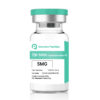TB-500 (Thymosin Beta 4) (5mg / 10mg)
$57.00 – $99.00
TB-500, known as Thymosin Beta-4, consists of a 43 amino acid sequence. Research in animal models indicates its potential in enhancing blood vessel growth, regulating wound healing, reducing inflammation, and mitigating oxidative damage in the heart and central nervous system. With roles in tissue protection, repair, regeneration, and active exploration in anti-aging studies, Thymosin Beta-4 holds promise for various therapeutic applications.
TB-500 Peptide: Synthetic Thymosin Beta 4
TB-500, or Thymosin Beta 4 in synthetic form, mirrors the naturally occurring protein’s potential properties. Researchers propose that TB-500 peptide may share similar mechanisms of action to Thymosin beta 4, potentially encompassing the stimulation of angiogenesis, enhancement of wound healing, and a speculated impact on tumor cell metastasis and hair growth.
TB500, characterized by excellent water solubility and a lightweight structure, is a 43-amino acid peptide abundantly present in wound fluid, including numerous blood platelets. This peptide shows promise in potentially possessing anti-inflammatory attributes and aiding in neurological recovery. Additionally, it may play a supportive role in the healing processes of the spinal cord, heart, and dermal tissues.(1)
TB-500 Peptide Composition
TB-500, also recognized as thymosin β(4), consists of a distinctive peptide fragment (17)LKKTETQ(23), serving as the active site and regarded by researchers as potentially influential in actin binding, cell migration, and the wound healing process.(4) The amino acid sequence of TB-500 is delineated as Ac-Ser-Asp-Lys-Pro-Asp-Met-Ala-Glu-Ile-Glu-Lys-Phe-Asp-Lys-Ser-Lys-Leu-Lys-Lys-Thr-Glu-Thr-Gln-Glu-Lys-Asn-Pro-Leu-Pro-Ser-Lys-Glu-Thr-Ile-Glu-Gln-Glu-Lys-Gln-Ala-Gly-Glu-Ser-OH.
Scientists recognize actins as pivotal players in wound healing, contributing to acute inflammation, collagen deposition, contraction, and remodeling processes. If TB-500 prompts an increase in actin levels, it could potentially enhance tissue repair mechanisms.(3) Additionally, owing to its low molecular weight and high solubility, TB-500 exhibits versatility and mobility, suggesting its potential to traverse long distances within an organism.
Investigations and Clinical Trials
TB-500 Peptide Early Investigations
In 1964, Dr. Goldstein and Professor Abraham White embarked on research primarily centered around the thymus gland and its operations. They isolated minute proteins secreted by the thymus, positioned beneath the breastbone and above the heart, leading to the discovery of Thymosin. Throughout the study, the research team proposed the notion that the functionality of the thymus gland could potentially influence immune deficiency and hormone release.(2)
TB-500 Peptide and Healing of Acute Injuries
In 1999, an investigation was carried out using rat models with inflicted wounds, where TB-500 was administered. The researchers observed that four days post-treatment, the rats receiving TB-500 exhibited a notable 41% increase in re-epithelialization compared to the control rats treated with saline. After seven days, the wounds in the TB-500 group were reported to have contracted by at least 11% more than those treated with saline. Upon thorough examination, it was inferred that TB-500 potentially stimulates angiogenesis and collagen deposition, leading to an accelerated rate of wound healing.
TB-500 Peptide and Persistent Injuries
Experiments were conducted on regular rats and mice, diabetic mice, aged mice, and rats influenced by steroids. Each group underwent full-thickness punch wounds and was treated with TB-500 peptide. Results indicated that TB-500 exhibited the ability to expedite the wound healing process across all test models, irrespective of the pre-existing conditions. Additionally, phase 2 clinical trials were carried out on individuals with stasis and pressure ulcers, revealing that TB-500 could potentially hasten the healing process by up to a month.(6)
TB-500 Peptide and Cardiovascular Function
Pulmonary hypertension, identified as a progressive cardiovascular ailment, involves the constriction of pulmonary arteries, hindering blood ejection from the right ventricle. This condition can lead to increased pulmonary vascular resistance and pressure, potentially culminating in heart ventricular failure. Researchers have indicated that TB-500 may exert specific effects on the Notch3-Col 3A-CTGF gene axis in mice influenced by monocrotaline (MCT). In the context of the study, this action resulted in a noteworthy reduction in right ventricular hypertrophy.(7)
TB-500 Peptide and Hair Follicle Stimulation
In 2003, investigations were conducted on mice to explore the potential impact of TB-500 on hair growth. Researchers reported that the administration of TB-500 peptide resulted in an increased number of hair shafts and hair follicles, as observed through histological examination of mouse skin cells. Utilizing real-time PCR and western blotting techniques, alterations in the expression of mRNA cells were identified between the TB-500 and control mice. Elevated levels of mRNA and proteins were noted in the TB-500 group, suggesting a significant induction of hair growth.(8)
TB-500 Peptide is exclusively intended for research and laboratory applications. Prior to placing an order, it is essential to carefully review and comply with our Terms and Conditions. The peptide is not intended for any other purposes beyond scientific research in controlled laboratory settings.







Reviews
There are no reviews yet.